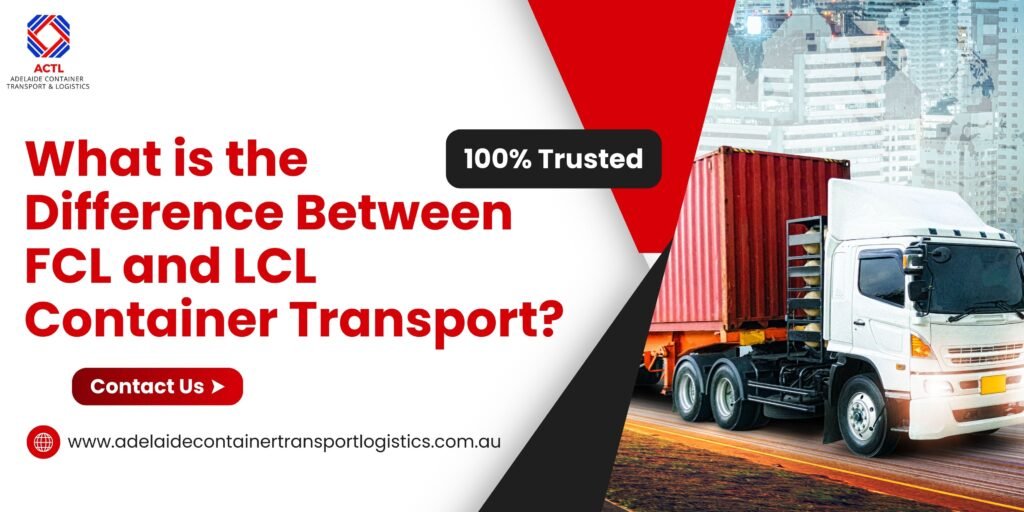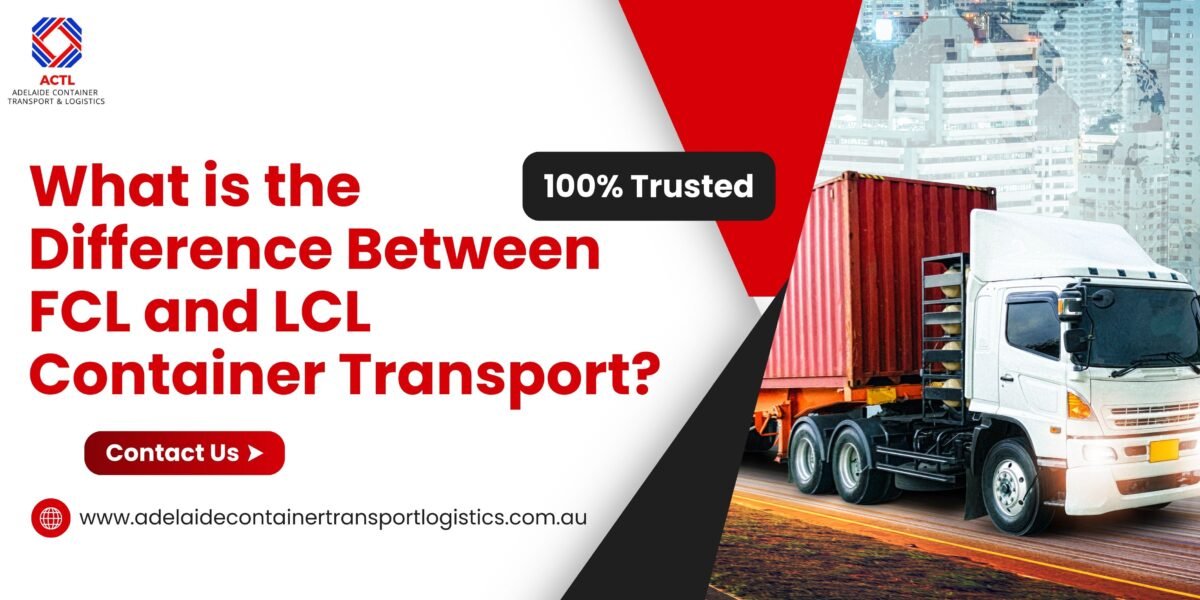
When planning international shipments, understanding the distinctions between Full Container Load (FCL) and Less than Container Load (LCL) is crucial for optimizing logistics and costs. Both methods offer unique advantages tailored to different shipping needs.
Full Container Load (FCL):
FCL involves dedicating an entire shipping container exclusively to your cargo. This approach is ideal for large shipments that can fill or nearly fill a container.
Advantages of FCL:
- Cost Efficiency for Large Shipments: The per-unit shipping cost is lower when transporting substantial volumes, making FCL economical for bulk goods
- Reduced Handling: Since the container is sealed and remains unopened until it reaches its destination, there’s minimal handling, reducing the risk of damage
- Faster Transit Times: Without the need for consolidation or deconsolidation, FCL shipments often have quicker delivery schedules.
Less than Container Load (LCL):
LCL allows multiple shippers to share space within a single container, making it suitable for smaller shipments that don’t require an entire container.
Advantages of LCL:
- Cost-Effective for Small Shipments: You pay only for the space your cargo occupies, which is economical for lesser volumes.
- Flexibility: LCL offers the flexibility to ship goods without waiting to accumulate enough volume for a full container.
Choosing Between FCL and LCL:
Consider the following factors when deciding:
- Volume of Shipment: Large volumes favor FCL, while smaller shipments are more suited to LCL.
- Budget Constraints: Evaluate the cost implications of both methods relative to your shipment size.
- Delivery Timeline: If speed is a priority, FCL might be the better option due to its streamlined process.
- Risk Tolerance: For fragile or high-value goods, the reduced handling in FCL can be advantageous.
At Adelaide Container Transport Logistics, we specialize in providing tailored shipping solutions across south Australia. Whether you’re considering FCL or LCL, our team is equipped to assess your needs and recommend the most efficient and cost-effective transportation method. Partner with us to ensure your cargo reaches its destination safely and on time.
When navigating the complexities of international shipping, one of the pivotal decisions businesses face is choosing between FCL and LCL Container Transport. This choice significantly influences shipping costs, transit times, cargo security, and overall supply chain efficiency. Understanding the nuances of FCL and LCL is essential for making informed decisions that align with your business objectives.
Full Container Load (FCL): An Overview
FCL shipping entails reserving an entire container exclusively for your cargo. This method is particularly advantageous for businesses with substantial shipment volumes that can fill a container entirely or nearly so.
Advantages of FCL:
- Cost Efficiency for Large Shipments: When shipping large quantities, FCL often proves more economical on a per-unit basis. The flat rate for the container means that the more you ship, the lower the cost per unit.
- Enhanced Security: With FCL, your goods remain sealed within the container from origin to destination, minimizing handling and reducing the risk of damage or theft.
- Faster Transit Times: FCL shipments typically experience fewer delays since they don’t require consolidation or deconsolidation with other shipments. This direct route often results in quicker delivery.
Disadvantages of FCL:
- Higher Costs for Smaller Shipments: If your cargo doesn’t utilize the full container space, you may end up paying for unused capacity, making FCL less cost-effective for smaller loads.
- Storage Requirements: Managing a full container necessitates sufficient storage space at both the origin and destination points, which can be a logistical challenge for some businesses.
Less than Container Load (LCL): An Overview
LCL shipping allows multiple shippers to share space within a single container. This method is ideal for businesses with smaller shipment volumes that don’t require an entire container.
Advantages of LCL:
- Cost-Effective for Small Shipments: LCL enables businesses to pay only for the space their cargo occupies, making it a budget-friendly option for smaller shipments.
- Flexibility: LCL offers the flexibility to ship goods without waiting to accumulate enough volume for a full container, allowing for more frequent shipments and better inventory management.
Disadvantages of LCL:
- Increased Handling: Since LCL shipments are consolidated with other cargo, they undergo more frequent loading and unloading, elevating the risk of damage.
- Longer Transit Times: The consolidation and deconsolidation processes can add to the overall shipping time, making LCL less suitable for time-sensitive shipments.
Key Considerations When Choosing Between FCL and LCL Container Transport
- Shipment Volume and Weight: FCL is generally more cost-effective for shipments that can fill at least half of a 20-foot container (approximately 15 cubic meters). For smaller volumes, LCL may be more economical.
- Budget Constraints: While FCL offers lower per-unit costs for large shipments, the total cost is higher. LCL allows for lower total shipping costs, which can be advantageous for businesses with limited shipping budgets.
- Transit Time Requirements: If speed is a priority, FCL’s direct shipping routes typically offer faster delivery. LCL shipments may take longer due to the additional handling involved.
- Cargo Sensitivity: For fragile, high-value, or temperature-sensitive goods, FCL provides a more controlled environment with less handling, reducing the risk of damage. LCL’s increased handling may not be suitable for such cargo.
- Storage and Handling Facilities: Consider whether you have the infrastructure to manage full containers at your facilities. FCL requires more storage space and equipment for loading and unloading.
Practical Scenarios Illustrating FCL and LCL Container TransportUse
- Electronics Industry: A company launching a new product line may opt for FCL to ship large quantities securely and swiftly to various markets, ensuring product availability aligns with marketing campaigns.
- Textile Industry: A fashion retailer introducing seasonal collections might choose LCL to ship smaller quantities more frequently, adapting quickly to changing fashion trends without overstocking.
- Automotive Parts Industry: A manufacturer requiring regular delivery of various components may use a combination of FCL for bulk items and LCL for specialized parts needed in smaller quantities.
Conclusion
Deciding between FCL and LCL container transport is a strategic choice that hinges on multiple factors, including shipment volume, budget, delivery timelines, and cargo characteristics. A thorough assessment of these elements will guide you toward the most suitable shipping method for your business needs.
At Adelaide Container Transport Logistics, we specialize in providing customized shipping solutions across Australia. Our experienced team is adept at evaluating your specific requirements to recommend the most efficient and cost-effective transportation method, be it FCL or LCL. Partner with us to ensure your cargo reaches its destination safely, on time, and within budget.
For more read – Mastering Interstate Shipping Container Transport: Essential Tips and Insights
Frequently Asked Questions (FAQs) About FCL vs. LCL Container Transport
1. What is the difference between FCL and LCL shipping?
FCL (Full Container Load) means your cargo exclusively occupies a container, while LCL (Less than Container Load) involves sharing container space with other shipments. FCL is ideal for large volumes; LCL is suitable for smaller, cost-effective shipments.
2. What container sizes are used in FCL and LCL shipping?
Common container sizes include 20ft and 40ft containers. FCL uses the entire container, while LCL shipments share space within one of these container sizes.
3. Can I combine FCL and LCL shipments?
Yes, some businesses use both—FCL for bulk items and LCL for smaller, time-sensitive parts. Our team at Adelaide Container Transport Logistics can help tailor this hybrid solution.
4. How do I know which shipping method is right for me?
It depends on your cargo volume, budget, delivery timeline, and risk tolerance. Contact Adelaide Container Transport Logistics for a free consultation—we’ll assess your needs and recommend the best option.

